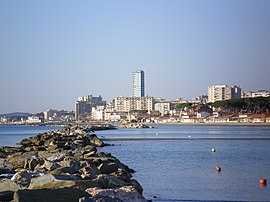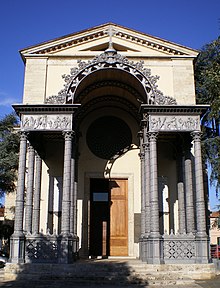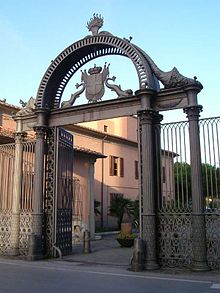Follonica
| Follonica | ||
|---|---|---|

|
|
|
| Country | Italy | |
| region | Tuscany | |
| province | Grosseto (GR) | |
| Coordinates | 42 ° 55 ' N , 10 ° 46' E | |
| height | 4 m slm | |
| surface | 55.84 km² | |
| Residents | 20,906 (Dec. 31, 2019) | |
| Population density | 374 inhabitants / km² | |
| Post Code | 58022 | |
| prefix | 0566 | |
| ISTAT number | 053009 | |
| Popular name | Follonichesi | |
| Patron saint |
San Leopoldo (November 15) |
|
| Website | Follonica | |
 View of Follonica |
||
Follonica (emphasizes Follònica ) is an Italian municipality with 20,906 inhabitants (as of December 31, 2019) in the province of Grosseto in the Tuscany region . The city emerged as an industrial settlement in the 19th century. Follonica has a relatively modern cityscape and is now one of the largest seaside resorts in Tuscany.
geography
Follonica is located in the Maremma Grossetana landscape on the Tyrrhenian Sea , on the southern foothills of the Colline Metallifere . The municipality borders the province of Livorno in the north , the provincial capital Grosseto is about 45 km south-east. The Gulf of Follonica, named after the city, extends from Piombino in the northwest to Punta Ala in the southeast. The island of Elba lies in front of the gulf to the southwest . The river Pecora flows in the southeastern municipality .
Follonicas neighboring municipalities are Piombino ( LI ), Suvereto (LI), Massa Marittima and Scarlino .
history
The history of Follonica is closely linked to iron processing . In Etruscan times, there were facilities for smelting iron ore in what is now the municipality, which was conveniently located between Populonia and Vetulonia . In the district of Rondelli, 21 ovens were found in which hematite from Elba was processed. This complex was abandoned in the 5th century BC. Other archaeological finds have been made in the hills inland, including lime kilns on the slopes of Poggio Fornello .
The place name, attested from the early Middle Ages, is probably derived from Fulloni or Folliculum , expressions for the bellows that conducted air into the melting furnace .
In the Middle Ages there was the castle Castello di Valle (also Valli ), attested from 884 , of which ruins have been preserved on a hill north of the city center. It was initially the summer residence of the bishops of Lucca , later it belonged to the Abbey of San Bartolomeo di Sestinga, from the 12th century to the Aldobrandeschi family , and from the second half of the 13th century to Pisa.
From the beginning of the 15th century, the area belonged to the Principality of Piombino under the Appiani, who set up an iron foundry again. This has been attested since 1546 and was taken over and expanded by the Medici in the course of the 16th century . Until the beginning of the 19th century, iron smelting was the only economic activity in Follonica, as the Maremma swampland did not allow agriculture and malaria was widespread.
From 1832 to 1836 Leopold II had the modern iron factory Reali e Imperiali Fonderie built next to the old foundry , and in the following years Follonica became the most important location for iron and steel production in the Grand Duchy of Tuscany and one of the starting points for draining the Maremma. The wetlands around the industrial site were parceled out, sold to settlers and drained. However, the new settlement grew only slowly. In 1854 the place had only 364 inhabitants. Today Follonica is the second largest municipality in the province of Grosseto.
Population development:
| year | 1871 | 1901 | 1921 | 1936 | 1951 | 1971 | 1991 | 2001 | 2016 |
|---|---|---|---|---|---|---|---|---|---|
| Residents | 852 | 1,805 | 3,414 | 5,727 | 7,818 | 16,775 | 21,353 | 21.091 | 21,443 |
Source: ISTAT
In 1923 Follonica became a separate municipality, until then it was administratively part of Massa Marittima.
After the steelworks had been subordinated to the Società Anonima Alti Forni e Fonderie di Piombino in 1897 , which was incorporated into the ILVA group in 1918 , the Tuscan steel production was concentrated in Piombino in the following years. In 1960 the plant in Follonica was finally closed. The most important economic factor of the municipality, next to small and medium-sized industry, is today summer bathing tourism, which developed from the 1960s. Follonica has a long sandy beach and a wide range of tourist facilities.
Culture and sights
building
The cityscape of Follonica is mainly characterized by modern buildings, but there are also several villas from the beginning of the 20th century in neoclassical or Art Nouveau style (e.g. Villa Benedetti , Villa S.Anna and Villa Jole Monciatti ).
The most important monument is the parish church Chiesa di San Leopoldo . According to a design by Carlo Reishammer and Alessandro Manetti , it was built from 1836 to 1838 for the growing settlement. The classical church combines stone masonry with various cast iron elements (column portal, rosettes) and is one of the first examples of iron architecture in Tuscany.
The former company site of the ironworks ( Area ex ILVA ) was rededicated, and the former industrial and administrative buildings now house various public facilities. The site is part of the Parco Nazionale Tecnologico Archeologico delle Colline Metallifere Grossetane National Park, established in 2002 . The cast iron entrance gate in the classical style is the work of Carlo Reishammer. A museum established in 1995 ( Museo delle Arti in Ghisa nella Maremma ) documents the history of mining and iron smelting as well as the history of the ILVA company. An archaeological museum ( Museo Archeologico di Follonica ) is being planned. Other facilities are a branch of the University of Siena , as well as the municipal library in the former mechanical workshops.
The municipal art museum Civica Pinacoteca Amedeo Modigliani mainly exhibits paintings by contemporary Italian artists.
Remains of the medieval castle Castello di Valle , which is located on a hill in the interior of the country, exist, including the keep and some outbuildings, some of which have been reconstructed. In the district of La Pievaccia , on the Poggio Chiecco hill , there are the remains of another medieval settlement, including a fortified tower from the 13th century.
nature
Parts of the municipality of Follonica belong to the nature parks
- Parco Interprovinciale di Montoni , in the northern part of the municipality towards Piombino;
- Riserva naturale statale biogenetica Tomboli di Follonica , along the coast with dunes and pine forests;
- Riserva Naturale Statale della Marsiliana - hill country towards Massa Marittima.
Regular events
- Carnival of Follonica, with parades and carriages of the different districts (since 1949)
Sports
Follonica has a successful roller hockey club , the ASD Consorzio Etruria Follonica Hockey , which has won several Italian championships. In 2006 the club won the European Cup and in 2007 the Intercontinental Cup.
The Ippodromo dei Pini is the city's harness racing track.
traffic
Follonica is on Strada Statale 1 Via Aurelia or the Aurelia variant that runs parallel to it from Grosseto to Livorno . Their departures are Follonica Est - Massa Marittima and Follonica Nord .
Follonica train station is on the Pisa – Rome railway line . From 1902 to 1944 a railway line ran from Follonica to Massa Marittima. This was not rebuilt after the destruction of the Second World War.
Town twinning
literature
- Toscana - Touring club italiano, Touring Editore (2005), ISBN 88-365-0948-7 .
Web links
Museo di Storia della Scienza , Florence:
Individual evidence
- ↑ Statistiche demografiche ISTAT. Monthly population statistics of the Istituto Nazionale di Statistica , as of December 31 of 2019.



